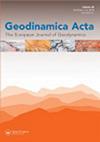Geochemical characteristics and age of metamorphic sole rocks within a Neotethyan ophiolitic mélange from Konya region (central southern Turkey)
IF 1.5
Q1 Earth and Planetary Sciences
引用次数: 20
Abstract
Palaeo- and Neo-Tethyan-related magmatic and metamorphic units crop out in Konya region in the south central Anatolia. The Neotethyan assemblage is characterized by mélange and ophiolitic units of Late Cretaceous age. They tectonically overlie the Middle Triassic–Upper Cretaceous neritic to pelagic carbonates of the Tauride platform. The metamorphic sole rocks within the Konya mélange crop out as thin slices beneath the sheared serpentinites and harzburgites. The rock types in the metamorphic sole are amphibolite, epidote-amphibolite, garnet-amphibole schist, plagioclase-amphibole schist, plagioclase-epidote-amphibole schist and quartz-amphibole schist. The geochemistry of the metamorphic sole rocks suggests that they were derived from the alkaline (seamount) and tholeiitic (E-MORB, IAT and boninitic type) magmatic rocks from the upper part of the Neotethyan oceanic crust. Four samples from the amphibolitic rocks yielded 40Ar/39Ar isotopic ages, ranging from 87.04 ± .36 Ma to 84.66 ± .30 Ma. Comparison of geochemistry and geochronology for the amphibolitic rocks suggests that the alkaline amphibolite (seamount-type) cooled below 510 ± 25 °C at 87 Ma whereas the tholeiitic amphibolites at 85 Ma during intraoceanic thrusting/subduction. When all the evidence combined together, the intraoceanic subduction initiated in the vicinity of an off-axis plume or a plume-centered spreading ridge in the Inner Tauride Ocean at 87 Ma. During the later stage of the steady-state subduction, the E-MORB volcanics on the top of the down-going slab and the arc-type basalts (IAT/boninitic) detached from the leading edge of the overriding plate, entered the subduction zone after ~2 my and metamorphosed to amphibolite facies in the Inner Tauride Ocean. Duration of the intraoceanic detachment (~87 Ma) and ophiolite emplacement onto the Tauride-Anatolide Platform (Tavşanlı Zone), followed by subsequent HP/LT metamorphism (~82 Ma) spanned ~5 my in the western part of the Inner Tauride Ocean.土耳其中南部科尼亚地区新特提斯蛇绿岩群变质底岩地球化学特征及年龄
在安纳托利亚中南部的科尼亚地区出现了与古特提斯和新特提斯有关的岩浆和变质岩单元。新特提斯的组合以晚白垩世的蛇绿岩和杂绿岩单位为特征。它们在构造上位于牛头地台的中三叠统-上白垩统浅海至远洋碳酸盐岩之上。科尼亚平原内的变质底岩在被剪切的蛇纹岩和哈尔茨布尔岩下以薄片的形式出现。变质底岩类型为角闪岩、绿帘石-角闪岩、石榴石-角闪片岩、斜长-角闪片岩、斜长-绿帘石-角闪片岩和石英-角闪片岩。变质底岩的地球化学特征表明,它们起源于新特提斯洋壳上部的碱性(海山)和拉斑岩浆岩(E-MORB型、IAT型和波长岩型)。4个角闪岩样品的40Ar/39Ar同位素年龄在87.04±0.36 ~ 84.66±0.30 Ma之间。对角闪岩的地球化学和年代学对比表明,海山型碱性角闪岩在87 Ma时冷却至510±25℃以下,而拉斑型角闪岩则在85 Ma时冷却至洋内逆冲/俯冲。当所有证据结合在一起时,洋内俯冲始于87ma时内牛头洋离轴羽流或以羽流为中心的扩张脊附近。在稳态俯冲后期,下行板块顶部的E-MORB型火山岩与上覆板块前缘的弧型玄武岩(IAT/ bonintic)脱离,在~2 m后进入俯冲带,变质为内牛头海角闪岩相。海内拆离(~87 Ma)和蛇绿岩侵位到Tauride- anatolide台地(tavanlyi带)以及随后的HP/LT变质作用(~82 Ma)的持续时间为~5 Ma。
本文章由计算机程序翻译,如有差异,请以英文原文为准。
求助全文
约1分钟内获得全文
求助全文
来源期刊

Geodinamica Acta
地学-地球科学综合
CiteScore
4.50
自引率
0.00%
发文量
0
审稿时长
25 weeks
期刊介绍:
Geodinamica Acta provides an international and interdisciplinary forum for the publication of results of recent research dealing with both internal and external geodynamics. Its aims to promote discussion between the various disciplines that work on the dynamics of the lithosphere and hydrosphere. There are no constraints over themes, provided the main thrust of the paper relates to Earth''s internal and external geodynamics. The Journal encourages the submission of papers in all fields of earth sciences, such as biostratigraphy, geochemistry, geochronology and thermochronology, geohazards and their societal impacts, geomorphology, geophysics, glaciology, igneous and metamorphic petrology, magmatism, marine geology, metamorphism, mineral-deposits and energy resources, mineralogy, orogeny, palaeoclimatology, palaeoecology, paleoceanograpgy, palaeontology, petroleum geology, sedimentology, seismology and earthquakes, stratigraphy, structural geology, surface processes, tectonics (neoteoctonic, plate tectonics, seismo-tectonics, Active tectonics) and volcanism.
Geodinamica Acta publishes high quality, peer-reviewed original and timely scientific papers, comprehensive review articles on hot topics of current interest, rapid communications relating to a significant advance in the earth sciences with broad interest, and discussions of papers that have already appeared in recent issues of the journal. Book reviews are also included. Submitted papers must have international appeal and regional implications; they should present work that would be of interest to many different specialists. Geographic coverage is global and work on any part of the world is considered. The Journal also publishes thematic sets of papers on topical aspects of earth sciences or special issues of selected papers from conferences.
 求助内容:
求助内容: 应助结果提醒方式:
应助结果提醒方式:


